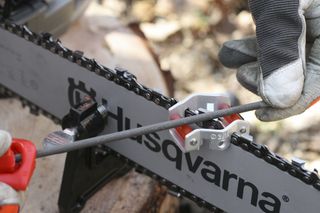
How-To's & Guides
Limbing thick branches
A different work technique is used for limbing thick branches than that used for thin branches. This applies to leaf trees and other trees with thick, extensive branches. The working technique often matches the technique used for crosscutting. In order to avoid splitting and the guide bar pinching, it is important that you use the correct technique and sequence.
Basic rule
Working from the outside and in towards the trunk.
Remember:
How are the branches tensioned? Be aware how the tree and branches move as you saw. When cutting very thick branches, it may be necessary to cut with a meeting cut, i.e. from two directions, to avoid pinching and splitting.
Right sequence
- Cut the branches that are obstructing your work.
- Branches with high tension are cut in stages to gradually ease the tension.
- Main branch is cut. Be aware of the tension and how the tree and branches move as you saw.

Examples of methods when crosscutting thick branches
Gradual reduction of the tension in the branch
- Make a few cuts, about 1/3rd of the branch diameter of the inside of the bow.
- Cut gently from the outside of the bow until the branch breaks.
Crosscutting thick branches without splitting
- Make a cut on the underside of the branch, up to half the branch diameter a little bit from the trunk.
- The next cut is sawn on the branch’s top side, a few centimetres beyond the first cut, up to half the branch diameter.
- The branch will break between the cuts along the wood fibres.
Soft breaking of a tensioned branch
- Hold the chainsaw as shown below. Saw a bit into the guide bar so that you do not risk coming close to the kickback zone on the guide bar tip.
- Saw carefully, in stages, a diagonal cut on the outside of the bow until the branch breaks.

Related articles
Showing 10 of 158









